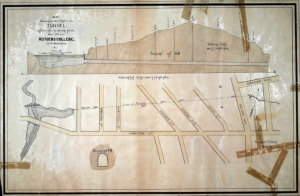Steven Leichner, Makenzie Bayless, Isha Khosla, Connor Grant
Section 2

The copper mine is currently under, what is today, the Voorhees Mall on the College Avenue Campus. It runs parallel to Hamilton Street and Mine Street. It passes through Robinson Street, Hartwell Street, Guilden Street, Easton Ave, Union Street, and College Avenue. The mine is about 60 feet under the ground and allegedly runs hundreds of feet under the Raritan River. The Dutch created many mines in New Jersey during the 1600s. The New Brunswick mines were first discovered fruitful in the 1750s when the owner of the land, Philip French discovered heavy chunks of copper. Philip French, the reason we have a French Street, had to soon allow a copper mining company to lease his farmland. The mine is no longer used.
In 1751, a New Jersey mining company led by Elias Boudinot contracted a century-long lease on French’s farm. The company subsequently dug a mine approximately 300 feet from the Raritan River and uncovered heaps of copper. The mines that are now replaced by Rutgers University’s property tells the story of the Dutch that arrived in America and attempted to make a profitable living through the mining industry. Stories of the Dutch can be seen through investigations of Ford Hall, which has a tunnel that used to be a mine shaft. The investigation discovered locked up rooms, crawl spaces, and stairwells that indicated previous activities in the underground tunnel. The mine shafts created by the Dutch are also involved in other parts of American history. The mine that once ran down Mine Street is said to have been a means of escape for slaves and a passage for smuggling alcohol during Prohibition.
The fact that there are little-known, yet extensive, mines under the College Avenue campus illuminates that New Brunswick has a deep, rich history that is not very well-known to the Rutgers community. A portion of this mine shaft, as previously mentioned, is even present in Ford Hall. It’s a shame that we tend to be so present-oriented, and that there is a long history of this area that is often neglected. We picked the mine shaft largely because of its relative anonymity. When Makenzie first mentioned that there were abandoned mines right underneath College Avenue, I was very surprised and wondered how many people even knew about the mines. For this reason, we thought we should do our project on the mines; to give people this same surprise, and broaden their knowledge of the history of New Brunswick.
The underground mine shafts located below certain areas on the College Avenue campus are a simple microcosm of the extensive history surrounding Rutgers University. Much of this history is not recognized by the students and faculty of Rutgers, alongside the other inhabitants of the city of New Brunswick. I believe the unknown presence of these shafts, especially those used as escape routes for slaves, a passage for arms, and the transportation of alcohol during Prohibition, are something that would fascinate others if they knew. To realize there is something out of view that is so complex and historically valuable right below the streets we walk on is captivating, but also unfortunate that its presence is generally not acknowledged. It teaches us that no matter where we are, there is a history behind our environment that we should learn to embrace because modern society tends to ignore these facts. Who would have known the reason why MIne Street has its name? Ultimately, we should look beyond what is present in our field and sight to gain a new appreciation for the world around us and teach others to do the same.
BIBLIOGRAPHY:
http://www.njgeology.org/enviroed/minemaps.htm
http://newbrunswicktoday.com/article/flooding-brought-end-mining-operation
http://www.state.nj.us/dep/njgs/enviroed/oldpubs/SG-Annual-Report-1906.pdf
http://www.state.nj.us/dep/njgs/enviroed/oldpubs/bulletin57.pdf
